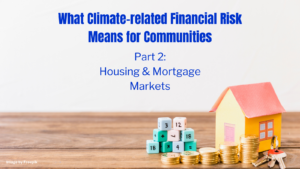
What Climate-related Financial Risk Means for Communities: Part 2 – Housing & Mortgage Markets
Climate change-driven events—like heat waves, droughts, floods, and fires—cause damage to communities’ and individuals’ health and safety. But these events also threaten the financial well-being of communities across the U.S. through their impact on markets and local economies. These risks are increasingly visible in the housing and mortgage markets.
In this three-part series, we’ll be breaking down how the climate crisis is creating risk for three key financial systems—and how these risks to the insurance system, the real estate market, and community banking can affect communities.
Part 2: Climate-related risks to the housing and mortgage markets
For many people, their home is their most important financial asset—which is increasingly put at risk by the impacts of climate change.
While the economic costs of climate-related hazards have been growing, there is mounting concern that housing markets are failing to fully price these risks, creating moral hazard and potentially causing real estate bubbles to develop. Indeed, previous work by EDF researchers has shown that residential properties exposed to flood risk are overvalued by $121–$237 billion.
Impacts to communities—and how regulators can respond
Incomplete pricing of climate risk may be driven by lack of information about potential future losses, cognitive biases that lead to misperceptions about the frequency and severity of natural hazards, and the socialization of costs associated with exposure to climate-related hazards (e.g., federal flood insurance and disaster recovery aid). By insulating current homeowners from the costs associated with climate impacts, these factors may bring short-term stability to housing markets and home values.
However, unpriced climate risk simultaneously incentivizes continued development in high-risk areas and underinvestment in hazard mitigation, further increasing the total cost of climate impacts. This means that risk is continuing to grow, and when a disaster occurs, damages will be much higher. At some point, state and federal policy changes could trigger a reassessment of housing values to reflect the true risk. That could lead to a massive loss of wealth for many homeowners and to budgetary shortfalls for local governments.
These potential consequences of the climate risk housing bubble, the time horizon over which they occur, and their effect on the stability of the housing market will largely depend on how policymakers and the multiple players in the housing and mortgage markets respond to increasing climate hazards. State and federal policy interventions that close climate risk information gaps and transfer climate risk from American taxpayers to those homeowners directly exposed to impacts have the potential to drive price deflation in high risk housing markets and thus might deflate any housing bubble; by contrast, policies that inhibit access to climate risk information and that insulate homeowners from climate-related costs may worsen housing inflation in high-risk areas.
We argue that policymakers in the US should aim for a “soft-landing” in repricing climate risks. Similar to how central banks gradually increase interest rates to reduce inflation, while simultaneously aiming to avoid a recession, state and federal government have an important role to play in deflating the climate risk housing bubble following a gradual, predictable, and transparent pathway.
In this context, an important feature of a “soft-landing” is achieving a balance between efficiently pricing climate risk while protecting those who are most vulnerable to its impacts. Beyond just slowly capitalizing climate risks, this means also implementing targeted policies that protect and build resilience specifically among low-income and socially vulnerable populations. These policies could include increasing investments in hazard mitigation, making more funding available for relocation to safer areas, and subsidizing insurance premiums.
Impacts to mortgage lenders—and how regulators can respond
There are also concerns about climate-related financial risks to residential mortgage lenders, and in turn, how lenders are insulating themselves from these risks. Recent work has established causal relationships between flood events, other types of climate-related hazards, and mortgage payment outcomes. After Hurricane Harvey in 2017, mortgage delinquency rates among flood damaged properties in Houston increased by 205%. Following wildfires in California, mortgage prepayment rates among damaged properties have increased by 16 percentage points. These mortgage payment outcomes are often mediated by households’ access to insurance. However, regardless of whether the risk is characterized by delinquency or prepayment, lenders are beginning to face growing losses from climate-related disasters.
To begin to better understand the scope and magnitude of this climate-related financial risk, the Federal Reserve is conducting a Pilot Climate Scenario Analysis. This exercise is requiring the six largest banks in the U.S. to evaluate how a major hurricane in the Northeast under future climate change, as well as another participant-chosen hazard, could affect the credit risk of their real estate portfolios. Based on a range of climate scenarios, recurrence intervals, and assumptions about insurance uptake, the banks will report the probability of default and loss given default for each loan or facility in their portfolios. The results from this exercise are specifically for information gathering purposes and will not have any regulatory implications or direct impacts on how the Federal Reserve will supervise the banks. Despite its narrow scope, this assessment is an important first step to get financial institutions and regulators thinking about how to evaluate financial exposure to climate impacts.
It remains unclear how mortgage lenders should be (or could be) regulated in the face of these increasing risks. While pricing climate risk in mortgages can reduce perverse incentives for continued development in high-risk areas, lenders must avoid replicating the tragic and unjust impacts of red-lining by disproportionately pricing loans higher for historically marginalized populations. At present, some lenders seem to be increasing interest rates for properties exposed to sea level rise while others are rationing credit by requiring higher down payments or tightening lending standards. Recent evidence also suggests that lenders are increasingly transferring the credit risk associated with flooding to ‘government-sponsored enterprises’ (i.e., Fannie Mae and Freddie Mac), whose debts are backed by taxpayers through increased securitization of mortgages in flood-prone areas. As risks grow, it has been proposed that Fannie Mae and Freddie Mac could transfer this risk back to lenders via higher guarantee fees for government-backed loans in high-risk areas and could broaden and enforce mandates to carry flood insurance.
Together, these mechanisms for transferring credit risk can increase the cost of accessing credit and decrease credit availability, resulting in price deflation of properties in high-risk areas. Although this could lead to a loss of wealth for many households, access to cheap credit for flood zone properties could alternately trap low-income people in high-risk areas, leaving many without the financial means to recover when a disaster hits. In developing regulations designed to mortgage credit risk in the face of climate change, it is critical that policymakers carefully manage this tradeoff between access to homeownership and exposure to climate risk, especially among vulnerable populations. Policymakers should center the expertise and priorities of affected communities in designing solutions to these problems.
How EDF is working to address climate-related risk to the housing market
The risk of climate extremes is growing, along with chronic climate stressors such as sea-level rise. Climate change is causing costs to skyrocket for households, all levels of government, and the private sector. To design effective and equitable policies for mitigating these financial risks, EDF is researching how weather-related disasters affect household finances and how these risks may shift under future climate change. Specifically, we are evaluating how credit and debt outcomes are affected by climate-related disasters and how various climate adaptation strategies can mediate the distribution of these risks. This research allows us to advocate for policy changes that drive equity, resilience, and financial security for vulnerable communities.











